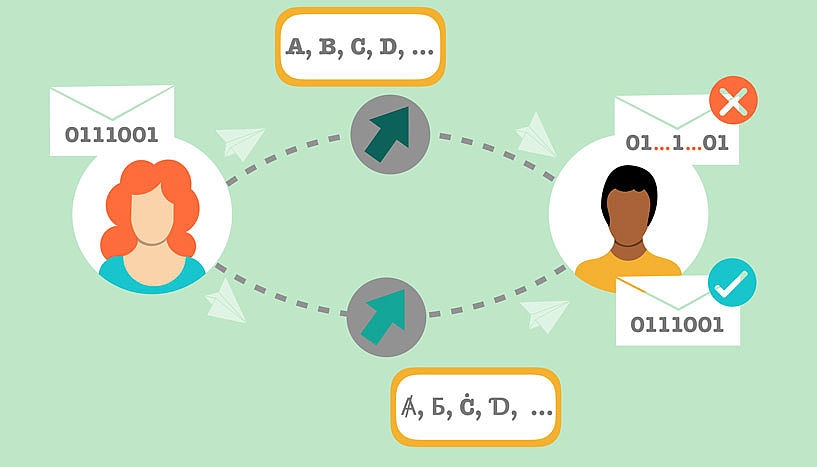Sep 4 2019
Quantum information is dependent on the potential to write messages in a quantum particle and to read them out in a secure way. However, in case the particle is relativistic, implying that it travels with velocities close to the speed of light, standard methods cannot decode the message clearly and the communication fails.
 Anna writes a message to Bill using the spin of an electron, which travels at velocities close to the speed of light. If Anna and Bill use the usual procedure for reading the spin (visualized as the standard Latin alphabet), Bill is unable to decode the message, and the communication fails. If they use a new definition of the spin of the electron (pictured as the modified alphabet), the message is read out correctly, and they are able to use the electron to communicate (Image credit: Flaminia Giacomini).
Anna writes a message to Bill using the spin of an electron, which travels at velocities close to the speed of light. If Anna and Bill use the usual procedure for reading the spin (visualized as the standard Latin alphabet), Bill is unable to decode the message, and the communication fails. If they use a new definition of the spin of the electron (pictured as the modified alphabet), the message is read out correctly, and they are able to use the electron to communicate (Image credit: Flaminia Giacomini).
A new technique for reading and writing the message developed by scientists from the University of Vienna and the Austrian Academy of Sciences could enable reliable decoding of quantum messages that are conveyed very fast. The study outcomes have been reported in the journal PRL and pave the way for possibilities of technological applications in quantum communication and quantum information.
Consider the following situation: Anna and Bill intend to exchange a message using a property of a quantum particle, for instance, an electron’s spin—an intrinsic form of rotation of a particle. Bill requires Anna’s message as fast as possible. Hence, Anna must send the electron at maximum speed, extremely close to the speed of light.
In view of the fact that Anna has localized the electron in her laboratory, one of the basics of quantum physics, Heisenberg’s uncertainty principle, prohibits the electron’s velocity from being defined with arbitrary precision. If the electron moves very fast, that is, relativistically, the interplay between quantum physics and special relativity makes the velocity and the spin of the electron to get entangled.
This correlation, which is stronger compared to what is classically feasible, renders Bill unable to read out the spin using the standard technique. Is it possible for Anna and Bill to enhance their communication strategy?
A research team headed by Časlav Brukner from the University of Vienna and the Institute for Quantum Optics and Quantum Information (IQOQI-Vienna) of the Austrian Academy of Sciences has launched an innovative alternative to the regular alphabet used by Anna and Bill.
Their method ensures that the message, written by Anna and read by Bill, can be decoded clearly even if the particle behaves based on both quantum mechanics, due to Heisenberg’s uncertainty principle, and special relativity, because of its extremely high velocity.
The innovative technique, which was described in the Physical Review Letters journal, offers a new interpretation of the spin of quantum particles that travel very fast. Thus, it alters both the way Anna writes the message and the way Bill reads it.
Vital to this method is a “translation” of the manner in which the message would be written and read between the regular alphabet, used when the electron is at rest, and the new alphabet, used when the electron moves extremely fast.
“These results are indicative that this translation procedure could open up to new applications in relativistic quantum information,” stated Flaminia Giacomini, the lead author of the study. For example, this method could prove useful in satellite-based quantum communication, in which a particle carrying a message has to move very fast between two distant points.